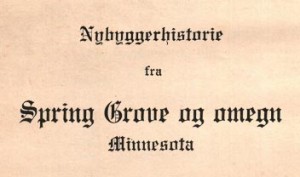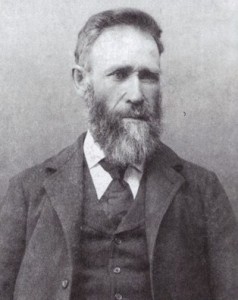 When his chores were done, farmer Ole S. Johnson, who lived just east of Spring Grove, traveled around the region in his horse and buggy and talked with those early settlers who were still around in the 1910s. Their generation was on the way out, and Johnson endeavored to interview as many as possible – over 260, in the end.
When his chores were done, farmer Ole S. Johnson, who lived just east of Spring Grove, traveled around the region in his horse and buggy and talked with those early settlers who were still around in the 1910s. Their generation was on the way out, and Johnson endeavored to interview as many as possible – over 260, in the end.
Over coffee at the kitchen table or out in the barn while the milking was done, Ole asked pioneers to tell their stories. From his home farm in Section 9, Wilmington Township, he traveled all around Black Hammer, Spring Grove and Wilmington Townships in search of his subjects.
As he collected biographies from pioneers, he contributed them as a series of chapters to Samband, the publication of the Valdres emigrant association (Valdrislaget). After almost 30 contributions to Samband, in 1920 Johnson published a collection called Nybyggerhistorie fra Spring Grove og Omegn (Settler History of Spring Grove and Region). As the title suggests, the book is written in Norwegian (and has many good examples of pidgin Norwegian), and it runs over 440 pages. It’s not very well organized or indexed, however, so may take awhile to find the entry you want. I have transcribed his list of early settlers, which as far as I can tell is a list of his biography subjects. Some entries are rather short, yet others extend over 5 pages.
Nybyggerhistorie is available in a few local libraries, including the Spring Grove and La Crosse libraries, and at the Vesterheim and Luther (Preus) libraries in Decorah. It’s also available at the Minnesota History Center in St. Paul. There is also a translation, which covers only Spring Grove, in the La Crosse library. Johnson also wrote a 4-volume collection on emigrants from Ringerike.
For genealogists and historians, Nybyggerhistorie provides a lot of what we miss by collecting names and dates. Johnson seemed to have a few stock questions, but they draw out some remarkable stories of the journey to America and life in the early settlements. To illustrate the quality of material available here, I have translated one biography below.
Example entry: Ole O. Engen
Ole Olsen Engen the elder was born at Nes in Hallingdal the 3rd of October 1842 to parents Ole Nilsen and wife Margit, nee Rotneim. His father was born in 1806 and mother in 1812.
His father was born at Nes, but had a place in Rukkedalen that was called Myre. His grandfather was Nils Myre and grandmother was called Sigri Brænno. Ole Engen’s mother was from Rotneim in Gol and her parents were Peder Rotneim and wife Sara. His mother’s siblings were Arne, Aslaug and Barbra. His father had no siblings.
In 1857 he immigrated to America together with his parents and ten siblings and took the ship “Familien” (The Family), which sailed from Drammen in the month of April. Among his traveling companions were Asle Grimsgaard and many others from Hallingdal. At the end of May they arrived in Quebec, from where they went by canal boat to Montreal and over the Great Lakes, and by train to Prairie du Chien, and from there by steam ship to Brownsville. In Brownsville came the order to go ashore, and their cargo was cast onto the shore. There they stood, these two large families, Grimsgaard and Engen, 24 people in all, of whom some were children who were so small they had to be carried in arms, and stood without knowing the difference between north and south or which way they should go. Finally they discovered that there was only one way which led back and forth from Brownsville, again got their luggage that stood on the shore and began their way upward. But with luck and happiness they met two famers who would be going to town without a load of wheat, who they got to freight their luggage to Spring Grove, which was the journey’s end. Though they were on the way, the wife of Asle Grimsgaard and also the wife of Ole Engen each had a child to carry on this long journey. Arriving in Caledonia in the twilight they met Iver Kinneberg, the first person they could speak with, and he had them follow him home, which they accepted with thanks. After they had come to Iver Kinneberg’s home, the child that Mrs. Grimsgaard had carried the whole way died, and the child that [Ole Engen’s] mother carried is now Mrs. Ole Myhre in Wilmington.
The morning after they came to Kinnebergs, Gunvald Tyribakken came for them with oxen and drove the Engen family to his place, where they got temporary housing until later.
They were poor times here in the country when Ole Engen came: low prices on all types of farm products, tight work and low daily wages. Ole got his first work for Knut Gulbrandsen in Spring Grove. Knut had operated a lime kiln and by getting work there Ole earned his first cents here in America. Later he got some work at Hans Myhro’s place. Wages were 25 cents per day plus costs. In the harvest he got work with Jo Rosheim and earned 50 cents per day there. Brita Rosheim, wife of Jo, was really a giant, Ole found. She could work like a man outside and still have food ready for the workers at the right time. She helped out in the field and bounded after mowers as quickly and ably as some men. One day the household was without meat, and when she finished out in the field a short time before dinner, she went to the house, slaughtered a little pig, prepared the evening meal and had food ready at the exact time when the people came home to eat. Ole was astonished at how she could do this so quickly.
One day she was out working in the evening and she was struck by a rattlesnake, but instead of getting a doctor with an antidote, she grabbed a scythe and cut out the area around the bite on her arm, tore off some of her skirt to make a bandage around the wound and continued working as if nothing had happened. The snake’s venom didn’t hurt Brita Rosheim as much as when the serpent poisoned all of humankind [in the Garden of Eden?].
Ole also worked one time for Ole Berg and got 4 dollars per month in wages there, and when he had earned his first 5 dollars he felt rich and thought this was a lot of money.
By making use of both winter and summer to work hard and live a thrifty life, his father was able to save so much that he bought 80 acres of land about 6 miles southeast of Spring Grove in the town of Wilmington, and there Ole worked on his father’s farm. In 1864 he agreed to enlist in the civil war and served one year. But when the rebels’ spirit was almost broken, he didn’t get in a blow. He was one of those who sat guard.
Coming back from his service in war, he and his brother Ole bought 160 acres of land together that they later divided. As prosperity rose a little he could buy more land and became the owner of 375 acres of valuable land in Wilmington and 160 acres in North Dakota.
In 1867, he was married to Anna, nee Rudsvigen, from Nes, Hallingdal. She was born the 5th of December 1846 and came to America in 1866 together with her parents and three siblings. One of her brothers had emigrated the year before she left and another brother came a year after. Her father, Reier Rudsvigen, was born in Drammen and came (perhaps as a young man) to Nes in Hallingdal, where he once ran a mill. He was respected as a very wise man and sought as a good advisor, was lively and modest and could associate with anyone. He never drank intoxicating drink and thereby was an example for others to follow. He reached an age of almost 100 years.
Ole O. Engen and wife had 12 children in their marriage, of which 6 live and reside in the following places: Margit, born 22 April 1868, lives in Wisconsin. Ole, born 22 December 1870, resides in Caledonia, Minn. Peder, born 19 December 1873, lives in North Dakota. Nicolai, born 12 November 1881, also lives in North Dakota. Barbra, born 13 February 1876, lives here in the county. Sara, born 22 May 1884, lives on her father’s farm.
Women’s role in pioneer hardships is often forgotten when talking or writing about those who first took possession of land and had to undergo all the struggles and grief that came along with clearing it. But it must be said that women took a full part in creating their homes. She did her part outside as much as inside the house, with caring for and milking the cows, raking the hayfields, helping with the harvest, etc. This was also Anna Engen’s lot. As an accomplished householder and hardworking wife she certainly contributed her share to create the assets that they came to own. The same as with those whose industriousness and thrift lead them to prosperity, the Engens built a hospitable home. Their servants and workers considered Ole Engen and wife as members of the family. They speak their mother tongue genuinely and unadulterated. An Irishman who worked for them a long time learned to speak so authentically as a Halling that he could have been born and grown up in Nes in Hallingdal.
Seven or eight years ago, Ole Engen and wife bought a house in Caledonia, where they now reside.
Of the twelve siblings, in addition to their parents who emigrated from Nes in Hallingdal in 1857, are now four who live, namely: Kjersti, now Mrs. Peder Rask; Margit or Mrs. Ole Myhre; Ole the younger who lives in Climax, Minn.; and our Ole the elder whose life is described.
Though Ole O. Engen is as real and true an American as a native; reads, writes and speaks the country’s language; was willing to sacrifice his life for the eradication of the abomination of slavery; and is bound as much to this land as a man to his wife, he hasn’t forgotten his native land but regards it as a married man does his mother.
I will here let Ole O. Engen have the last word himself. He said: “I have subscribed to “Skandinaven” [a Norwegian-language Chicago newspaper] for 50 years and also to several other Norwegian newspapers. Similarly I have subscribed to several English newspapers. All my children were confirmed in Norwegian but some of them of them have become such English speakers that they teach their children only English. I think that it’s a great shame that they don’t teach their children Norwegian. I am not ashamed that I am Norwegian and a Halling as well. I, for my part, don’t think that it’s bad that some could be multi-lingual, because the Norwegians are not inferior to any other nationality. “



Pingback: Nybyggerhistorie fra Spring Grove og omegn Minnesota by O. S. Johnson on Peder & Kjersti Rask | Teff History
Pingback: Peder & Kjersti Rask | Teff History